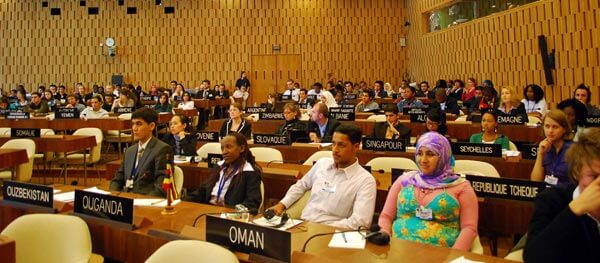A world-changing consensus emerging at the UNESCO Youth Forum in Paris
Siena AnstisWebsite

Delegates at the Unesco Youth Forum in Paris are articulating a completely new worldview. Photo by Siena Anstis.
Over the past four years I have had the great fortune of being able to live and travel in different places around the world. As I made it my job to spend time talking with youth from these different countries—primarily Uganda, Kenya, Canada, Denmark and Kosovo—I quickly discovered that we have one common and highly relevant role: together, we are rendering borders less relevant in the traditional sense.
Borders in the nationalistic, political, religious and economic dimensions of today’s world are artificially dictated by individuals who profit from these exacerbated differences. The 2008 post-election crisis in Kenya is a perfect example: both President Mwai Kibaki and Prime Minster Raila Odinga were powerful leaders exploiting ethnic differences as a means of uniting votes and remaining in power. Instead of focusing on the structural problems of poverty and land distribution, they pulled out a more tangible separation—that of ethnicity—and refused to let go.
But today’s youth bring a different perspective. Already a tangible reality in our lives, we are willing these borders into irrelevance.
As the UNESCO Constitution states: “Since wars begin in the minds of men, it is in the minds of men that the defenses must be constructed.” Youth around the world bring a new moral flexibility that promotes cooperation between previously sworn enemies.
For example, Behar Xharra, a young Kosovar, feels equally comfortable working with Serbian youths as with his own Albanian brethren and he helps ensure that a cross-border dialogue is maintained between peers, as a means of stabilizing the unsteady political climate that Kosovo was born into. Youth in the Obunga Slum in Kisumu, a town in Kenya’s Western Province, call for the celebration of cultural and ethnic diversity in their country, as well as the end of ethnic stereotypes that has divided their country.
While governments often exploit ethnic and religious differences, such as former President George Bush’s stereotyping of Islamic culture as an “axis of evil”, a strong and growing contingent of youth actively transcend these imposed borders. In Montreal, young Israelis stand hand in hand with Palestinians hoping for the liberation from incessant conflict; French Canadians mingle easily with Anglophones even while they continue to support the once-violent separatist movement.
The desire of youth to continue building this global nation—through the use of direct dialogue and increasingly useful social networking tools like Facebook and Twitter—is a powerful movement that will not be broken by rigid governments or an economic crisis. Indeed, many young people have decided to turn these obstacles into an opportunity to further solidify this global perspective despite great adversity. Through global alliances, “le capitalisme casino” is rendered inadequate and unsustainable. Instead of advocating another extreme ideology, such as Communism, youth are developing a method of sustaining humanity which relies on a global understanding. These strong alliances will sustain the pressures of differences and help ensure that people resort to violence less and less frequently.
The UNESCO Youth Forum is a great opportunity for this perspective to continue flourishing. In just one room, there are representatives of 109 countries. Such a meeting of minds, whether or not our leaders pay any attention to the recommendations of youth during the upcoming 35th UNESCO General Conference, will resonate across the world. The baggage of the Cold War, anti-Islamic hate, and extreme Zionism is slowly eroding and being replaced by new values of a generation that celebrates diversity, which brings new alternatives to the globe’s problems.
While I do not want to paint an overly idyllic picture, there is something brewing beneath the surface which offers youth a vision of a global world where differences are to be appreciated, not manipulated. In the long-run (for there is no “quick fix” to the world’s current management) humanity might learn from its mistakes.
[October 2, 2009, 12:42 pm: This article originally displayed the incorrect author; it’s now been corrected.]